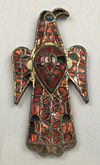Asia Bikini Girls 027
Middle Ages

Post-Roman Europe continued to develop jewellery making skills; the Celts and Merovingians in particular are noted for their jewellery, which in terms of quality matched or exceeded that of Byzantium. Clothing fasteners, amulets, and to a lesser extent signet rings are the most common artefacts known to us; a particularly striking celtic example is the Tara Brooch. The Torc was common throughout Europe as a symbol of status and power. By the 8th century, jewelled weaponry was common for men, while other jewellery (with the exception of signet rings) seems to become the domain of women. Grave goods found in a 6th-7th century burial near Chalon-sur-Saône are illustrative; the young girl was buried with: 2 silver fibulae, a necklace (with coins), bracelet, gold earings, a pair of hair-pins, comb, and buckle.[17] The Celts specialized in continuous patterns and designs; while Merovignian designs are best known for stylized animal figures.[18] They were not the only groups known for high quality work; note the Visigoth work shown here, and the numerous decorative objects found at the Anglo-Saxon Ship burial at Sutton Hoo Suffolk, England, are a particularly well-known example.[12] On the continent, cloisonné and garnet were perhaps the quintessential method and gemstone of the period.
The Eastern successor of the Roman Empire, the Byzantine Empire, continued many of the methods of the Romans, though religious themes came to predominate. Unlike the Romans, the Frankish, and the Celts, however, Byzantium used light-weight gold leaf rather than solid gold, and more emphasis was placed on stones and gems. As in the West, Byzantine jewellery was worn by wealthier females, with male jewellery apparently restricted to signet rings. Like other contemporary cultures, jewellery was commonly buried with its owner.[19]
Source from : http://en.wikipedia.org/wiki








No comments:
Post a Comment